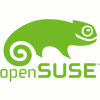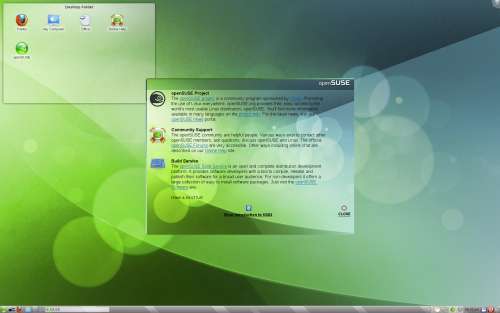- Qualcomm Launches Snapdragon 4 Gen 2 Mobile Platform
- AMD Launches Ryzen PRO 7000 Series Mobile & Desktop Platform
- Intel Launches Sleek Single-Slot Arc Pro A60 Workstation Graphics Card
- NVIDIA Announces Latest Ada Lovelace Additions: GeForce RTX 4060 Ti & RTX 4060
- Maxon Redshift With AMD Radeon GPU Rendering Support Now Available
An In-Depth Look at openSUSE 11.3

Since it’s been quite a while since I last took openSUSE for a spin, I couldn’t resist downloading the 11.3 release that came out in mid-July. To see how the distro fares today, I installed it onto my home PC and used it for just over a week. So, read on for an in-depth look at what’s new and notable, and also for my experiences.
Page 4 – openSUSE 11.3 Experiences
Because most common distros use either GNOME or KDE, the difference between them comes down to their background and foreground software, such as package managers and configuration tools. Of course, ease-of-use comes into things as well, because even if two distros use a desktop environment you’re pleased with, if one requires a day’s worth of studying to install, it’s probably not going to be well-received.
openSUSE is a distro that’s tailored to support novice and advanced Linux users alike, so it’s no surprise that the installation process was a total breeze. Compared to other leading distros, I’d have no problem in saying that openSUSE offers the easiest installation, especially with regards to the partition configurator. Then there’s the sheer control. You can configure everything during the install from the boot-loader to installed software packages to whether or not SSH will be enabled at boot. It offers a complex number of options, yet remains simple to use and understand.
We covered the installation earlier though, so I’ve already repeated myself too much. How about the OS itself and the experience? Well, I’m happy to report that openSUSE discovered all of my hardware and configured it (almost) perfectly. At the desktop for the first time, my display’s resolution was set properly and the desktop was speedy graphics-wise, thanks to the Nouveau GPU driver being installed.
Before I did anything in the OS, I simply rebooted the PC a second time, in order to make sure that nothing would break. It might seem like an odd step, but all too often I’ll install an OS (not just Linux), and after the first reboot, see something go awry. Here, something did go a little screwy, and there are two reasons for it. I mentioned earlier that due to a faulty NIC on my motherboard, the Ethernet wasn’t configured properly before I hit the desktop, and as a result of this, the SUSE updater icon in the system tray was distorted, for whatever reason. While it might not be related to the lack of an Internet connection, I never encountered that minor issue again since.
The taskbar theme also changed in between the reboots, which I found a bit strange. Even stranger, I had the same exact thing happen when I installed 11.3 in a virtual machine, so it really does seem like something is not quite right. Once you install a proper GPU driver, this “issue” disappears.
A rather frustrating issue I encountered was that the second audio card in my PC didn’t work properly, even though it was detected fine. That card is ASUS’ Xonar Essense STX, which uses the snd-virtuoso driver. Through applications like KMix, the volume sliders functioned fine, and I’d even get functional playback when using Amarok or playing a video through YouTube… but there was no actual audio coming from my speakers (rather, headphones).
I spent a couple of hours on this issue, and I couldn’t figure out a solution. What I came to surmise is that openSUSE was, according to YaST, using the snd-oxygen driver for the Xonar card, rather than the snd-virtuoso, which it should have been. While audio cards exist that use a similar chipset (CMI8788) and do use snd-oxygen, Xonar cards are the exception.
In the end, I decided to let this issue slide, since I would have spent an unknown amount of time on it, and since I’d just be purging the install a week or so later, it clearly wasn’t going to be worth it. Even now, I’m still not quite sure what the solution would be, because if you compile the Xonar driver in the kernel, you automatically get the snd-oxygen driver (and both will be loaded as modules when in use). It’s a strange issue, to say the least. I truly believe that if I were using a non-Xonar card, I wouldn’t have had this issue.
While I’m tackling strange occurrences, another lies with “My Computer”. This is an icon found on the desktop, and it leads you to a specialized HTML page “sysinfo:/”. Here, you can get a quick overview of various bits of information about your PC, quick links to common folders, and also a run-down of the available partitions on the machine. You can see how things looked on my PC below:
From the get-go, my Windows partition and also my /home were displayed fine, in addition to the currently-mounted DVD-ROM. Here, I had expected to be able to click on a partition link and have it open up in Dolphin, KDE’s file manager, but instead, I received an error, “There is no application installed that can open files of the type block device (inode/blockdevice).”
From that, I simply assumed that these links couldn’t be clicked on. That raised the question as to the reason for their existence on that page, and not to mention the even less-useful mention of partitions there that weren’t even mounted. After I mounted a couple of other partitions, the view changed, as you can see below. Still, clicking on them yielded the same error as above.
After a couple of days, I decided to click on the My Computer icon again, and for fun, I clicked on one of the partition URL’s to see if anything changed. To my surprise, things did change. When I clicked on the URL’s, I was now brought directly to the root folder of that mount just fine. For /windows/C, I found myself at the equivalent of C: on a Windows machine, and /home as you’d expect brought me right to that folder in Dolphin.
I’m not sure why this functionality suddenly began to work after a couple of days, but I’m assuming it had something to do with an online update. While on topic, though, it would have been nice to have a drive auto-mount if I clicked on it. Instead, users will need to haul out their text editors and edit fstab, which isn’t exactly ideal for the novice. Auto-mounting drives seems like a common-sense thing to have in a distro to me.
These issues mentioned here were pretty much the only ones worth raising that I ran into, and to be fair, I experience just about the same – if not more – on other distros, so openSUSE did rather well here. If there’s just one more niggle of a complaint I have, it’s that getting certain pieces of software, or up-to-date software, can be complicated.
For example, YaST doesn’t normally include bleeding-edge versions of software in its repository, so if you want a version of a program that just came out, even recently, you might not be able to install it without issue. You can hope that a version is available on openSUSE’s software website, or if you are gutsy, you can go ahead and compile it yourself. That latter option will be a little time-consuming though, as you’ll need to install gcc and other required packages.
I do admit, I was taken back a bit by the lack of available software that I personally wanted. I’m not saying that YaST lacks software, because that’s far from being the case. But for what I use on a regular basis, I had to look into alternative install methods, rather than simply load up YaST and search for what I needed. Of the applications I wanted to install, those not found in YaST were Google Chrome, Google Earth, SMPlayer, VLC, Bluefish, VMware, Skype and Nero.
I can understand the omission of some of these, since they’re commercial or proprietary, but the lack of both Bluefish and VLC were a little puzzling, since both are open-sourced. To install most of these applications, I simply went to SUSE’s online repository and grabbed them there, or downloaded the RPM versions of a particular application on its respective website.
Some of the applications I mention above might incite a, “Do you really expect everything to be there?” response from some of you, but I’m coming from Gentoo, which has every-single one of those applications available in its repository, so it’s not completely outlandish to expect a wider selection of software to be available.
It should be noted, though, after you add some additional repositories, some of those applications mentioned will become available through YaST. In particular, SMPlayer and VLC became available after adding a popular media-related repository. Of all the applications I installed, Skype proved to be the most complicated. The application itself installed fine, but in order to actually have it function, I had to use YaST to install these additional packages: xorg-x11-libXv-32bit, libqt4-32bit, libqt4-x11-32bit and libpng12-0-32bit. I only mention these here because Skype is a popular program, and it might prove useful to someone.
Support our efforts! With ad revenue at an all-time low for written websites, we're relying more than ever on reader support to help us continue putting so much effort into this type of content. You can support us by becoming a Patron, or by using our Amazon shopping affiliate links listed through our articles. Thanks for your support!










